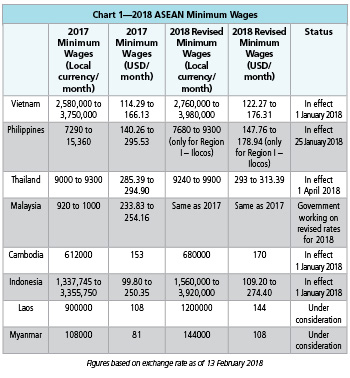In 2018, Vietnam, along with several Association of Southeast Asian (ASEAN) countries, will see a rise in its minimum wages to support the rising cost of living. The region’s growth in the past few years has been largely attributed to the manufacturing industry, driven by low labor costs. More investors are adopting the “China Plus One” strategy—operating in China but also in at least one other Asian country--understanding the rise in wages will be crucial for maintaining the delicate balance between labor costs and productivity in Vietnam and its neighboring countries.
Vietnam’s Rising Minimum Wages
Vietnam has revised the minimum wage caps in effect from January 2018. Currently, there are two kinds of minimum wage.
- Common Minimum Wage—This is used to calculate salaries for employees in state-owned organizations and enterprises. The common minimum wage has been increased by 90,000 Vietnamese dong (VND) per month from 1,300,000 VND per month (US $57) to 1,390,000 VND per month (US $61), in effect from 1 July 2018.
- Regional Minimum Salary—The second type of minimum wage is used for employees in all non-state enterprises and is based on regions as defined by the government. From 1 January 2018, the National Wages Council has finalized the regional minimum salary rates for 2018 as follows:
- Region I: VND 3,980,000 per month (covers the rural and urban districts of Hanoi, Ho Chi Minh City, Hai Phong, Bien Hoa City, Thu Dau Mot City, Vung Tau City of Ba Ria-Vung Tau Province, and some rural districts of Dong Nai and Binh Duong Province)
- Region II: VND 3,530,000 per month (covers the remaining rural districts of Hanoi, Hai Phong, Hai Duong City, Hung Yen City, and some rural districts of Hung Yen Province)
- Region III: VND 3,090,000 per month (covers the remaining provincial cities, Chi Linh town, and some rural districts of Hai Duong and Vinh Phuc Province)
- Region IV: VND 2,760,000 per month (covers the remaining localities)
ASEAN Minimum Wages
In 2018, almost all the ASEAN nations will see a rise in minimum wages. Laos and Myanmar have already proposed new wages, while Malaysia is currently deciding on the new minimum wage structure (see Chart 1).
Chart 1—2017 and 2018 ASEAN Minimum Wages

Impact of Rising Wages
Wage increases often lead to an increase in consumer spending. With the domestic market growing in Vietnam and other ASEAN member states, the rising minimum wages will lead to an increase in consumption and offset any reduced investment and net exports to a certain extent. However, countries have to maintain the delicate balance among inflation, wage levels, and productivity so as to not to disrupt the overall labor market.
Low labor costs as a competitive factor are not sustainable in the long-term, and one should focus on the development of the service industry, high-tech industries, and domestic consumption for a sustainable growth like China.
This article was first published in Vietnam Briefing.
Since its establishment in 1992, Dezan Shira & Associates has been guiding foreign clients through Asia’s complex regulatory environment and assisting them with all aspects of legal, accounting, tax, internal control, HR, payroll, and audit matters. As a full-service consultancy with operational offices across China, Hong Kong, India, and ASEAN, we are your reliable partner for business expansion in this region and beyond.
For inquiries, please email us at [email protected]. Further information about our firm can be found at: www.dezshira.com